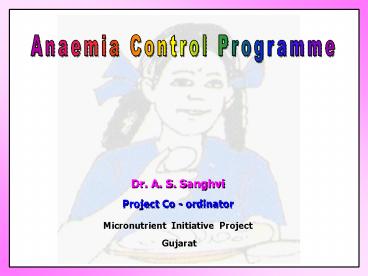Anaemia Control Programme - PowerPoint PPT Presentation
1 / 32
Title: Anaemia Control Programme
1
Anaemia Control Programme
Dr. A. S. Sanghvi Project Co - ordinator
Micronutrient Initiative Project Gujarat
2
(No Transcript)
3
Maternal Mortality and Anaemia
4
Maternal deaths
70 - 80 pregnant women
20 deaths
53 deaths
Causes directly
Affects
Causes indirectly
Causes
Haemmorhage Sepsis Toxaemia
Aggravates
Anaemia
5
Infant Mortality and Anaemia
6
Gujarats population 5.5 crore
Birth Rate 24.6 per 1000 population
Child births annually 13.5 lacs
IMR 50 per 1000 live births
65000 infants die annually
Contributes 50
Aggravates
Anaemia in mothers
Low birth weight infants
7
INTRODUCTION
Micronutrients
In small amounts
On a regular basis
Required by human body
8
IRON A MICRONUTRIENT
Iron is an essential micronutrient in human
nutrition. Iron is necessary for 1.
Formation of Haemoglobin 2. Development
function of brain 3. Regulation of body
temperature 4. Muscle activity
Lack of Iron directly affects the immune system.
It diminishes the number of T- cells and
production of antibodies.
9
Iron Deficiency
- Iron deficiency is the most common nutritional
disorder. - 30 of global population in the world are anemic.
- Iron Deficiency affects more people than any
other condition in the world, and remains silent
despite severe consequences .
10
IRON A MICRONUTRIENT
Iron is essential for binding of oxygen to the
blood cells i. e. RBCs. The main function of Iron
is Oxygen Transport
Cell respiration.
11
Sources of IRON
Plant Source
Animal Source
Haem Iron
Non - Haem Iron
Better absorbed
Less absorbed
Cereals , GLV, Legumes , Nuts, Oil seeds ,
Jagerry dried fruits.
Meat , liver , poultry, fish
Haem iron also promotes absorption of non
haem Iron
12
- Iron absorption is more when there is increased
demand for Iron e.g. during pregnancy.
- Only a small fraction (5 to 10 ) of the total
iron in the diet is absorbed.
13
Regulation of Iron
- The body has no mechanisms specifically
designed to excrete iron. - Normal losses that occur through the gut or skin
are very small. - Regulation of total body iron therefore occurs
through regulation of the absorption of Iron.
14
Total dietary Iron intake ( 28 mg/day)
Haem Iron
Non Haem Iron
Enhancers
10 of Dietary Iron is absorbed
Inhibitors
Iron absorbed from gut ( 2.8 mg/day )
Total body Iron (3 - 4 g )
Haemoglobin 75 Circulatory iron
Iron stores (5 )
Myoglobin (20 )
15
WHAT IS ANAEMIA ?
It is a condition in which haemoglobin
level in the blood falls below a standard
value which is age - sex specific .
Normal blood
Anaemicblood
Reduced Oxygen carrying capacity
16
CAUSES OF ANAEMIA
Diet deficient in Iron
Poor absorption of Iron available in the diet
Diet deficient in Iron
Blood Loss / Increased demand of Iron
Absence of Iron absorption Enhancers
- Cereals based diet
- Less consumption of Iron rich diet
Hookworm infestation
Presence of Iron absorption Inhibitors
Malaria
Start of menstruation
Poor bioavailability of Iron in Diet
During Childhood Adolescent
Deficiency of Vit.C,B12, folic acid
Frequent Pregnancy
17
VULNERABLE GROUPS
Pre - school Children
Adolescent Girls
Pregnant Women
Lactating Mothers
18
PREVALENCE OF ANAEMIA
19
PREVALENCE OF ANAEMIA
Nearly 50 population of India is suffering from
anaemia
7 out of 10 children below 5 yrs ( 70 Children )
6 out of 10 adolescent girls ( 60 adolescent
girls )
8 out of 10 pregnant women ( 80 pregnant women
)
20
DIAGNOSIS OF ANAEMIA
Lab Diagnosis By estimation of haemoglobin in
blood Cut off figures of haemoglobin levels
below which Anaemia is indicated Group Age Hb
( gm/dl of blood ) Children 6 months to 6
years 11 6 years to 14 years 12 Adult Males
13 Females 12 Pregnant Women 11
21
Clinical Diagnosis Anaemia can not always be
diagnosed through lab diagnosis because of non -
availability of facilities, particularly in
rural areas. Therefore, some of the following
symptoms and signs may help to suspect anaemia.
22
SYMPTOMS OF ANAEMIA
1. Excessive tiredness 2. Breathlessness on
slight exertion
23
SIGNS OF ANAEMIA
Pale and lusterless eyes
Spoon shaped nails
Pallor tongue
Oedema of feet
24
CONSEQUENCES OF ANAEMIA
A. In Children 1. Deterioration in school
performance. 2. School absenteeism. 3. Impaire
d brain development . 4. Mental
irritability. 5. Retarded growth.
25
B. In Adolescent Girls 1. Fatigue and
tiredness 2. Lack of interest in regular
activities 3. Lack of concentration, which
leads to poor performance in school 4. Poor
appetite
26
5. Poor overall growth 6. Delayed
menstruation 7. Less ability to prevent
infections 8. When anaemic adolescent girls get
married and become pregnant, they run the risk
of being more anaemic , which can have adverse
effects on both, the mother and the child .
27
C. In Pregnant Women 1. Birth of low birth
weight babies. 2. High infant mortality. 3.
High maternal mortality. 4. Impaired cognitive
development in newborn
Pregnant women, thus, form the highest
risk group calling for urgent interventions.
28
Control of Anaemia
Short Term measures
Long Term measures
Medium Term measures
Iron Supplementation
Food Fortification
Dietary Modifications
29
DIETARY MODIFICATIONS
1. Regular dietary intake of iron and folic
acid rich foods such as Green leafy
vegetables, Cereals like wheat, jowar, bajra,
pulses ( especially sprouted ones ), Jaggery,
Roasted bengal gram, etc.
30
2. Promotion of animal food - If
culturally and economically feasible.
31
3. Iron absorption enhancers - Intake of
vitamin C rich foods like lemon, amla, guava,
orange, germinated foods etc in diet enhances the
absorption of iron.
32
4. Iron absorption inhibitors Tannins
present in tea and coffee are the most potent
inhibitors of iron absorption. Taking tea or
coffee along with meals greatly reduces the
absorption of iron.

